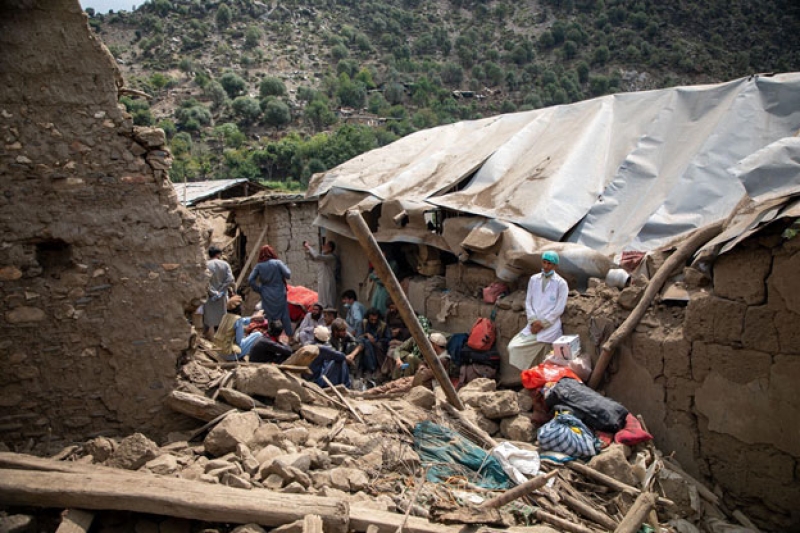- Ctg Port’s historic milestone in 2025 container handling, revenue |
- NBR Probes Bank Records of 100 Exporters Over Bond Abuse |
- Hadi murder case: Sanjay, Faisal give ‘confessional’ statements |
- Islami Bank organizes orientation for 1000 Trainee Assistant officers |
- 2025: People’s Resistance Against Hydro Projects in Himalaya |
Afghan Women Die Needlessly After Natural Disasters

A powerful 6.0-magnitude earthquake struck eastern Afghanistan late on 31 August 2025, with its epicentre near Jalalabad in Nangarhar province. A shortage of female doctors left women untreated as the quake’s toll mounted. Credit: UNICEF/Amin Meerzad
In normal times, women in Afghanistan face dire living conditions relative to their counterparts in other parts of the world, given the iron grip of Taliban repression. However, the powerful 6.0-magnitude earthquake that struck the eastern Afghan provinces of Kunar, Nangarhar, and Laghman at the end of August was out of the ordinary.
It was the deadliest quake to hit earthquake-prone Afghanistan in decades, and humanitarian efforts to reach the most vulnerable – usually women, children, and the elderly – were overwhelmed.
Nearly 700,000 homes and 500 hectares of farmland were damaged in Kunar alone, according to Afghan authorities.
But the only factor that was not a force of nature was the gender-based restrictions instituted by the Taliban, which aggravated the crisis for Afghan women.
In the affected areas, a serious shortage of female doctors led to a higher toll among women because male doctors did not have easy access to female victims due to gender segregation.
“Taliban edicts bar women from moving freely without a male guardian, ban them from many forms of work, and strictly limit access to healthcare,” according to a report by the UN Assistance Mission in Afghanistan.
In the aftermath of the deadly quake, residents from Kunar and Jalalabad said that women in these areas faced shortages of safe shelter and drinking water, while also battling health issues specific to women.
The condition of women and children in other areas such as Kunar, Nangarhar, and Laghman was equally poor.
The total death toll from the earthquake is estimated at 2,200 people. The exact number of female casualties remains unclear, but health workers in the affected areas have reported high death tolls among women and children.
Sharifa Aziz (a pseudonym), a member of the UNICEF relief team who spent three days in various parts of Kunar province, said over the phone: “The situation is extremely dire. When we first arrived, women cried tears of joy at seeing us. They said, ‘God’s angels have come to us.’” Their jubilation was understandable.
There were insufficient female workers to serve women’s needs, stemming from the Taliban’s overall clampdown on women’s participation in the labour market. Their participation in international humanitarian organizations’ work is also strictly limited.
As the earthquake was still unfolding, Susan Ferguson, the UN Women Special Representative in Afghanistan, issued a statement: “Women and girls will again bear the brunt of this disaster, so we must ensure their needs are at the heart of the response and recovery,” she warned.
According to her, after the major earthquake that hit Herat in 2023, “nearly six out of ten of those who lost their lives were women, and nearly two-thirds of those injured were women.”
After the quake struck, local news sources began reporting that the majority of the victims were women and children.
In some households, as many as five or six children lost their lives, and the death toll among women and the elderly was alarmingly high.
The Taliban eventually dispatched a team of mobile health workers to Kunar only after images on social media circulated on local television showing a shortage of female doctors in the affected area, according to Abdulqadeem Abrar, spokesperson for the Afghan Red Crescent Society.
However, residents say that with the rising number of injured people, they continue to face a shortage of female medical staff.
“After the severe earthquake in our area, we came to the hospital and brought in patients here. There is a serious shortage of female doctors. If there were more female doctors here, we would not have had to transfer our patients elsewhere,” complained Chenar Gul, a resident of Kunar.
As Tajudeen Oyewale, UNICEF’s representative in Afghanistan, pointed out in a posting on X, the role of female doctors is critical in responding to disasters such as earthquakes.
He added that female doctors treat children and women as well as men affected by the earthquake in these provinces. However, in humanitarian agencies without female staff, or where access is restricted, it is feared that women can be left untreated for several hours.
The growing concerns over the shortage of female doctors and healthcare workers — a contributory factor to the high toll exacted on women — should have brought home to the Taliban the negative impact of their policy. But in recent remarks, Zabihullah Mujahid, a Taliban leader, described the issue of girls’ education as “minor.”
For the fourth consecutive year, the Taliban have kept all universities, institutions, and medical training centres for girls and women closed, including specialised nursing and medical technology centres.
The scale of destruction caused by the 6.0-magnitude earthquake was exacerbated by poor infrastructure and a fragile healthcare system — a legacy of a country emerging from decades of military conflict — which explains the unacceptably high number of casualties.
However, it is within human capability to mitigate the severe impact of such recurring events on women. All it takes is for the international community to stand in solidarity with Afghan women by bringing relentless pressure on the Taliban government.

